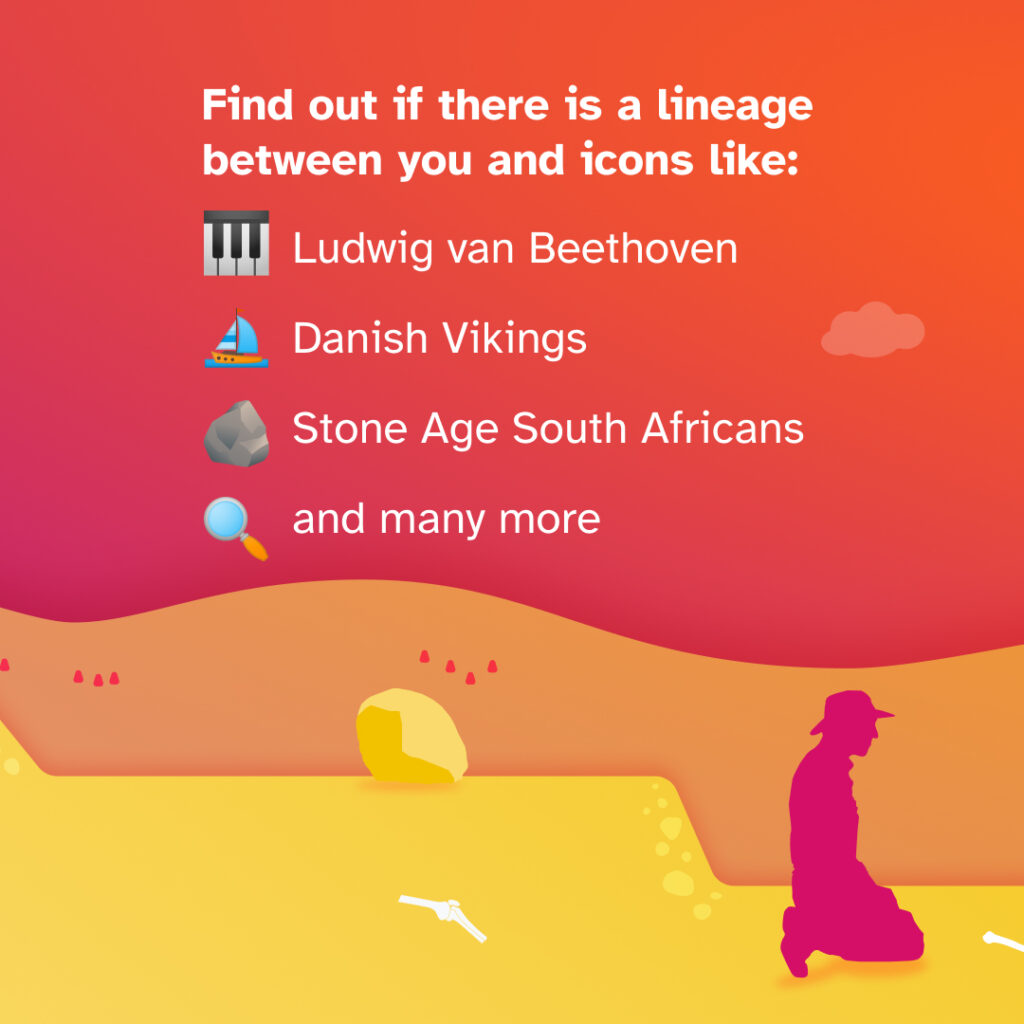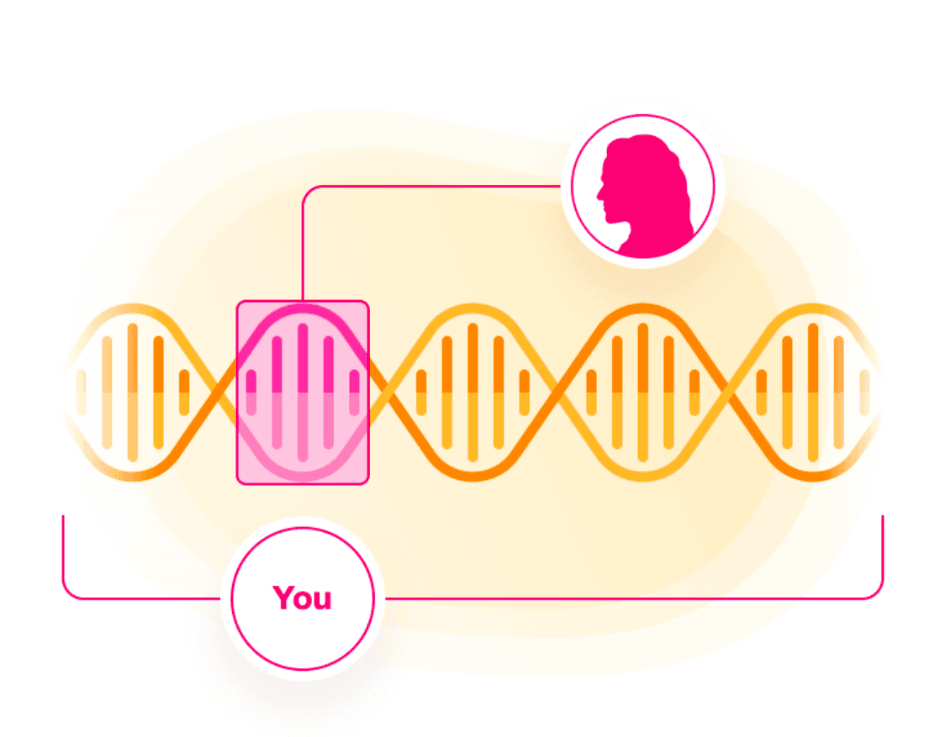Are you distantly related to the legendary, like the great musical genius Ludwig Van Beethoven? Perhaps you are genetically related to a high-status Viking woman from the 9th century who was buried in an ornate coffin with ornaments made of copper and a comb made from antlers? Maybe you’re linked to an African female Hunter-Gatherer buried with her bow and arrow and an ivory armband or a Caquetio man found with shards of decorated pottery at a site in Curaçao that dates back to before the first colonizers arrived in the Americas.
Woven into our DNA is a history thread linking us to our relatives, their stories, and the broader human story.

Historical Matches
This week, 23andMe launches its first iteration of “Historical Matches.” This powerful and unprecedented new 23andMe+ Premium feature may connect you to one or more of 335 historical people across the globe. The technology works by identifying places in your genome where you share identical DNA inherited from a shared ancestor. This might be someone who lived long before you or your historical match. This creates a new way to learn more about your connections to the past.
Over time, 23andMe plans to add more historical genomes to the feature, offering customers more opportunities to connect their stories to past epochs.
“23andMe’s Historical Matches is a technical breakthrough in our ability to accurately detect genetic connections between customers and historical individuals,” said Dan Chu, 23andMe’s Chief Product Officer. “It uses cutting-edge science to provide customers with connections to history that can be fun, and in some cases, deeply personal and profound.”
23andMe is the first leading DNA ancestry service to offer this level of genetic matching to relatives of historical peoples based on peer-reviewed published methods and deep data analysis.
Historical DNA
The cutting-edge science used to create this feature developed over more than a decade as scientists, including those at 23andMe, have leveraged new technology for extracting and sequencing ancient or historical DNA from bones found at archeological sites or, in Beethoven’s case, from a lock of his hair.

Pioneering work by Harvard Population geneticist David Reich and Nobel Prize winner Svante Pääbo at the Max Planck Institute for Evolutionary Anthropology advanced our understanding of those ancient populations, human migration, and the interrelationship between our archaic human cousins, the Neanderthals, and modern humans.
Over the years, ancient or historical DNA information has upended our ideas of human history and migration. It’s also starting to offer insights into the origin of disease that could point toward new treatments.
How 23andMe Matches to Historical Genomes
While previous ancestry features allowed customers to find out if they were genetically connected via their maternal or paternal lines, this new feature searches across the whole genome to connect members to historical individuals who lived hundreds or sometimes thousands of years ago by finding identical segments of DNA in their genomes.
The feature relies on publicly available data, scientific publications, and the 23andMe relative matching technology to link to these historical individuals.
Like 23andMe’s DNA Relatives feature, Historical Matches searches for shared segments of DNA between 23andMe+ Premium members and historical individuals. The feature identifies matches by finding segments and looking at the length of DNA that subscribers share with these historical individuals. Creating quality thresholds for how long a shared segment must be for a match makes it unlikely that there would be “false positive” matches.
Most 23andMe+ Premium members will have a match to one or more of these individuals. This offers them a connection to specific individuals from a particular time in history.
Most matches reveal very distant connections. Some matches may be much closer.
Who Are These Historical Figures
Some of these genomes are from individuals who lived thousands of years ago. Others are just a few centuries old. Almost all are relatively anonymous, except one of the more recent figures, Beethoven, who died in 1827.
The Historical Matches feature includes details about each historical individual. These reports also offer details of what we know about them, how they lived, and, in some cases, how they died. The feature recounts the history of their time and the details of artifacts found with them.

Beethoven’s musical genius is well known. Now, we also know about his genetic health predispositions. Researchers extracted DNA from a lock of his hair. In 2023, scientists from the University of Cambridge and the Max Planck Institute published an analysis of Beethoven’s genome, attempting to ascertain more about his progressive hearing loss, liver disease, and gastrointestinal issues.
Also in 2023, scientists from Harvard, the Smithsonian, and 23andMe conducted a historical DNA analysis of 27 enslaved and freed African Americans who labored at a Maryland iron furnace. The furnace operated during the American Revolution and into the 19th century. The study published in Science reveals a hidden history of people who lived and worked there. It also provides a technical and ethical benchmark for future studies of similar, largely forgotten burial sites. 23andMe’s new Historical Matches also include the genomes of nine individuals whose DNA was best preserved. Their names are lost to history. However, we know some of how difficult and, at times, brutal life was for the people who toiled at the furnace.*
Almost all 335 historical figures are anonymous, but these men, women, and children have a story to tell. Based on the original published studies, we’ve placed these individuals into different historical groups.

The Historical Groups
The Viking Age—The Vikings were Seafaring people of Scandinavia who made their indelible mark between the 8th and 11th centuries, known as the Viking Age.
Catoctin Furnace Ironworkers—The Catoctin Furnace Iron Workers were enslaved and freed African American laborers who toiled there between the 18th and 19th centuries. The site is one of the earliest industrial sites in the United States. The furnace produced iron goods, including shells fired during the siege of Yorktown. It also made ammunition for the Continental Army.
Iron Age Taiwan — The Iron Age in Taiwan refers to a period when the indigenous Atayal people began to use metals like bronze, iron, and silver.
The Ancient Eurasian Steppe—The Eurasian Steppe encompasses the massive grasslands and plains stretching from modern-day Hungary and Romania to Mongolia and China. It was also a crossroads for human migration and a hub for the spread of the Indo-European language.
The First Peoples of the Caribbean—This group includes indigenous people who lived in the region before colonization, between about 1,000 BC and 1500 CE, or just as Spanish explorers first encountered these communities.
The Genomic Formation of South and Central Asia — Most South Asian populations today descend from a mixture of two ancient populations that lived around 4,000 years ago. Scientists call these two populations “Ancestral South Indians” and “Ancestral North Indians.” Ancestral South Indians were also the product of two genetically distinct groups related to ancient Iranian farmers and southern Asian hunter-gatherers. That intermixing likely occurred around 2,000 BCE. Ancestral North Indians descended from pastoralists (herders) who lived in the eastern part of the Eurasian Steppe during the Bronze Age.
Late Stone Age and Iron Age South Africa—Many archaeological studies in Southern Africa focus on sites where our earliest human ancestors lived hundreds of thousands of years ago. However, there are also sites from the more recent past. There wasn’t a fixed date when the Late Stone Age ended in South Africa. However, the Iron Age began around 200 CE when Bantu-speaking people who experienced ironworking migrated to the region.
Ancient Northern Chinese Millet Farmers—The fertile basin between the Yellow and the West Liao rivers was once home to the world’s earliest complex agricultural societies. The communities there grew millet. Human migration from and through the region helped spread the cultivation of millet. Millet eventually became the staple crop of Northeast Asia, dating back almost 8,000 years.
The Ancient City of Beirut — Beirut, Lebanon has been inhabited for 5,000 years. It has been governed by many empires — Assyrian, Babylonian, Persian, Greek, Roman, Byzantine, Arab, and Ottoman. Each of these empires left a cultural mark but not always a genetic one.
Discover more with 23andMe
23andMe+ Premium members can visit their Historical Matches to explore their connections to these figures.
Not yet a 23andMe+ Premium member? Find out more about 23andMe+ Premium offerings here.
*Are you an existing 23andMe customer interested in discovering if you have a strong genetic connection to historical individuals buried at Catoctin Furnace? Are you a 23andMe+ Premium or Total Health member? If you are not, you may be eligible to receive information about significant genetic connections you have to individuals buried at Catoctin Furnace at no additional cost. Please visit this page for further information.




